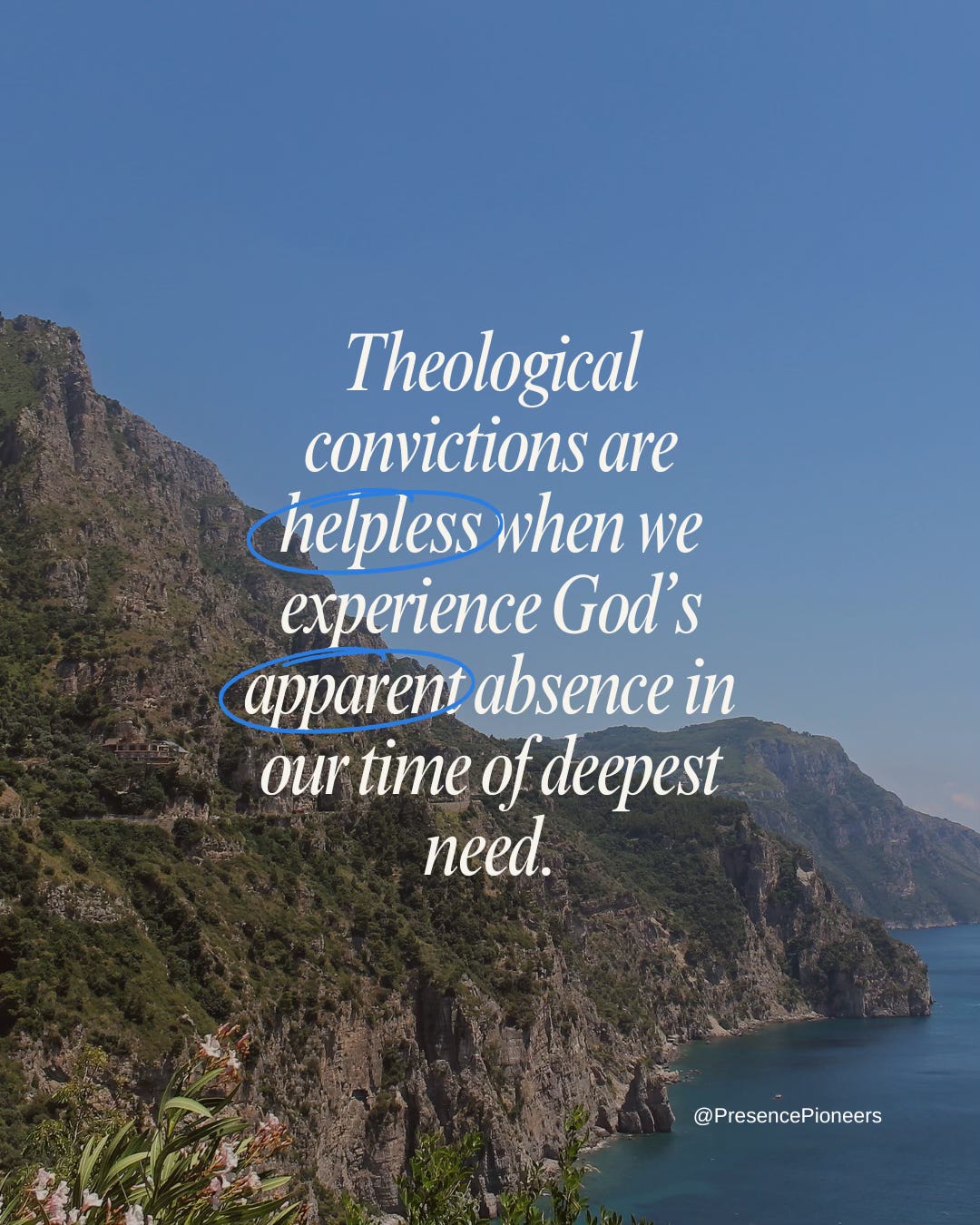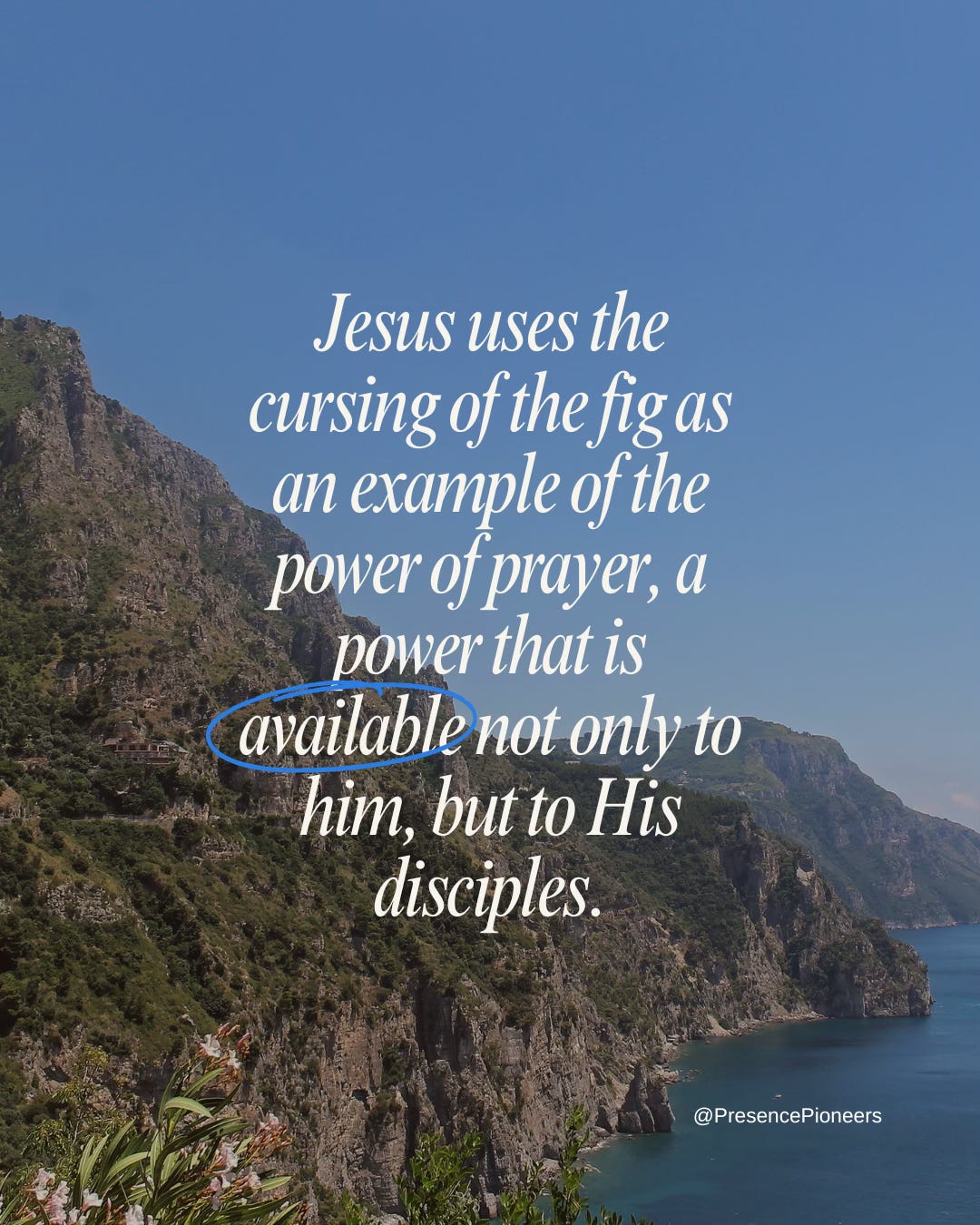The Secret of Always Answered Prayer (Part 1)
Does Jesus really teach that our prayers can always be answered “yes”? And if so, why are so many of our prayers unanswered?
This multi-part teaching will explore Jesus’s promises of always answered prayer in Matthew, Mark, and John.
As a child in church, I was taught to pray.
I remember the exact words of the catechism: “Prayer is a conversation of the heart with God.” And, as I spoke to God, he would answer my prayers in one of three ways: “Yes,” “No,” or “Wait.” Because God loves us and is much wiser, sometimes he does not give us what we ask for right away because He knows it will harm us then and help us in the future.
All in all, this is a good theology of prayer. We should talk to God about our needs and trust that he will respond for our good. It fits well with our personal experience of prayer. Sometimes our prayers are answered right away. Sometimes, the answer is “no” or “wait.” I would have no problem teaching this to my children.
And yet, when Jesus teaches on prayer, He repeatedly claims something different. He insists that we can have every prayer answered “Yes.” In fact, he claims this is what God wants to do and that it brings God glory (John 15:8).
The Reality of Unanswered Prayer
Everyone I know has experienced unanswered prayer, with effects ranging from trivial to traumatic. Most people do not lose their faith when they ask God for a birthday present that never comes. However, many atheists have stories of unanswered prayer in childhood at the root of their unbelief. Whether earnest requests for an encounter with God or the healing of a sick relative, unanswered prayer can lead some to believe God does not exist, or at least, does not care about them.
For me, the miscarriage of our first child after days and nights of earnest prayer challenged my trust in God like nothing else. Theological convictions are helpless when we experience God’s apparent absence in our time of deepest need.
Even though we have all experienced unanswered prayer, Jesus shockingly teaches that we can have every single prayer answered “Yes.” He teaches this not just in one passage, but multiple times and in different ways.
The gulf between Jesus’s promise and our experience of prayer is a scandal. His teaching and our experience of prayer do not match up. We can resolve the tension in one of two ways. Either Jesus’s words don’t really mean what they seem to mean (at face value), or we are extreme novices in prayer who have not understood and put Jesus’s words into practice.
When we see a gap between what the Bible says and our experience, we can either choose to lower the Bible to the level of our experience or take the more adventurous track of trying to raise our experience to the level of the Bible. The Scriptures are clear: Jesus really does gives us a “blank check” for always answered prayer. This suggests there is a massive, undiscovered country before us, a place in prayer where every request is answered.
Unanswered prayer is part of our experience. But it is not the Biblical standard.
The Promise of Always Answered Prayer in Matthew and Mark
There are three places in Scripture where Jesus teaches on “always answered prayer.” Matthew 21, Mark 11, and John 13-17. The accounts in Matthew and Mark are quite similar, so we will discuss them as a group before considering John’s gospel.
Matthew 21:21-22
“And Jesus answered and said to them, “Truly I say to you, if you have faith and do not doubt you shall not only do what was done to the fig tree, but even if you say to the mountain, ‘Be taken up and cast into the sea,’ it shall happen. And everything you ask in prayer, believing, you shall receive.”
Mark 11:22-25
“And Jesus answered saying to them, ‘Have faith in God. Truly I say to you, whoever says to this mountain, ‘Be taken up and cast into the sea,’ and does not doubt in his heart, but believes that what he says is going to happen, it will be granted him. Therefore I say to you, all things for which you pray and ask, believe that you have received them, and they will be granted you. Whenever you stand praying, forgive, if you have anything against anyone, so that your Father who is in heaven will also forgive you your transgressions.’”
The Conditions of Always Answered Prayer
Both Matthew and Mark present a conditional promise for always answered prayer.
“Everything you ask in prayer, believing, you shall receive.” Matthew 21:22
“All things for which you pray and ask, believe that you have received them, and they will be granted to you.” Mark 11:24
The condition that must be met for prayers to be always answered is something called “faith” or “belief.” Matthew says that you must have “faith and not doubt” and must pray “believing.” Mark gets more specific on the object of faith. One must first “have faith in God,” but then, he must “believe what he [is praying for] is going to happen.” He also says, “whatever you ask, believe you have received it.” In other words, the faith must be applied not just generally to God, but also to the object of prayer.
The Mark passage adds a second, implicit condition to always answered prayer, forgiving anyone who has sinned against you.
“Whenever you stand praying, forgive, if you have anything against anyone, so that your Father who is in heaven will also forgive you your transgressions.”
Matthew sees this same connection between forgiveness and prayer, presenting a very similar teaching in Matthew 6:14-15, immediately after the Lord’s Prayer.
Forgiving those who have sinned against us along with “faith” or “believing” are key conditions that qualify Jesus’s promise of always answered prayer. The promise cannot be claimed without forgiving everyone. Likewise, we must be full of faith in God, full of faith that we will receive the object of our prayer, and emptied of doubt to claim the promise.
The Context
The stories in Matthew and Mark both take place during Holy Week, immediately after the triumphal entry into Jerusalem and proximal to Jesus visiting the temple and driving out the money changers.
In Matthew and Mark, Jesus is walking outside of Jerusalem when He gets hungry, sees a fig tree, and, finding no fruit on it, he curses the tree. The fig tree withers up and dies to the roots.
His disciples are amazed and confused by this.
Jesus uses the cursing of the fig as an example of the power of prayer, a power that is available not only to him, but to His disciples. Not only can fig trees die through the power of believing prayer, but “if you have faith and do not doubt you shall not only do what was done to the fig tree, but even if you say to the mountain, ‘Be taken up and cast into the sea,’ it shall happen.”
At first glance, the story seems bizarre. Why does Jesus randomly curse and kill a fig tree, especially since Mark includes the detail that “it was not the season for figs.” Why does He pivot from cursing a fig tree to talking about throwing mountains into the sea? And how does all of this connect to the secret of always answered prayer?
A Fig Sandwich in Mark, A Vineyard in Matthew
Matthew and Mark both tell this story in immediate proximity to Jesus’s cleansing of the temple. However, they tell it in two different ways.
Matthew tells it right after Jesus visits the temple and drives out the money changers. It is notable that both the story of the fig tree and the cleansing of the temple are tied to prayer. As he drives out the money changers, Jesus quotes Isaiah 56:7, “My house shall be called a house of prayer for all nations, but you have made it a den of robbers.”
Mark starts the fig tree story in verse 12 on the way to the temple, then has Jesus cleansing the temple (v. 15), making a declaration about God’s house being “a house of prayer for all nations.”
In verse 20, after his confrontation in the temple, the disciples return to the fig tree and see it withered to the roots. Then comes Jesus’s teaching on always answered prayer.
By sandwiching the story of the cursed fig tree around the cleansing of the temple, Mark is driving home the connection between the two stories.
Jesus is not flying off the handle at a random fig tree. He is not “anit-fig” or “anti-tree.” Instead, the fig tree is symbolic of the temple, the Jewish leadership, and the nation of Israel. He came to the temple looking to find a house of prayer for all nations (the fruit) and instead found a den of robbers. Because his in-person investigation (see Gen. 18:20-21, Num. 5, Daniel 5, Rev. 2-3) did not reveal the fruit he was looking for, he curses the temple and unbelieving Israel as a whole. This coming judgement on Jerusalem and Israel is one of the ongoing subjects of holy week as described in Matthew 21-25 and Mark 11-13. As he will later predict in Matthew 24, “not one stone [of the temple] will be left on another.” So, while many (including me) call Jesus’s visit to the temple “the cleansing of the temple,” in reality, the temple is not cleansed. In fact, lasting judgement is declared against it.
Matthew makes the meaning of the fig tree clear by means of other parables. Notably, Matthew 21:33-44 tells the story not of a fig tree, but of a vineyard where the tenants kill the son of the owner, leading to the owner putting the tenants to death. Jesus tells them in v. 43 “The Kingdom of God will be taken away from you and given to a people producing its fruits.”
The meaning of the cursing of the fig tree is clear: Israel and Jerusalem are under judgement for ongoing sins but most of all for rejecting and killing the Messiah and missing the day of their visitation.
The sign of the fig tree was ultimately fulfilled in A.D. 70, when the Romans destroyed Jerusalem, not leaving one stone of the temple on top of another.
Things Got Heavy…Like a Mountain?
I began studying this passage wanting to know the secret to always answered prayer. I was not expecting the text to lead into heavy matters of God’s judgment on Israel or the nations.
However, the context makes it clear: Jesus is not mentally unstable and cursing random objects. He is enacting a prophetic sign. As the fig tree did not have fruit and so came under a curse and withered, so also the temple and unbelieving Israel were fruitless and under God’s righteous judgment.
Strangely, this is the context in which the son of God chose to give the promise of always answered prayer. But why talk about a mountain thrown into the sea? Why shift the metaphor from a tree to a mountain? And, getting back to our main line of inquiry, why is this an appropriate context to speak about always answered prayer?
A Mountain is Bigger than a Tree
First, we should note the obvious. A mountain is bigger than a tree. And thus, Jesus is saying that by the power of faith, his disciples can do greater things than even he has done. By implication, this also means His disciples will do greater things by prayer than what happened to Jerusalem in A.D. 70.
In speaking of a mountain being cast into the sea, Jesus is directly referencing Psalm 46:2
“Therefore, we will not fear, though the earth give way and the mountains fall into the heart of the sea.”
Because the fig tree represented a nation, it makes sense for the mountain to represent a nation or nations as well. As is clear throughout Psalm 46, the mountains falling into the heart of the sea speaks of kingdoms and nations that are being judged, destroyed, or experiencing a transition of leadership.
“Nations are in uproar, kingdoms fall; he [Yahweh] lifts his voice, the earth melts.” Psalm 46:6
The end-result of all the mountain removing is the Messianic Kingdom, where planet earth is united under God’s chosen ruler.
“He says [to the nations], ‘Be still, and know that I am God; I will be exalted among the nations, I will be exalted in the earth.’” Psalm 46:10
That’s right—the beloved verse “be still and know that I am God” is not really about your circumstances, it is about entire nations coming under God’s messianic king. I hope you’ll continue to apply it to your personal circumstances, just with added insight into the context.
This is the passage Jesus has at the forefront of His mind as He teaches about always answered prayer.
While Psalm 46 is referenced directly by Jesus, the symbolic connection between “Kingdom” or “Nation” and “Mountain” is reflected throughout the Old Testament. This image is seen in the dream of Nebuchadnezzar in Daniel 2, and again in Zechariah 4, Zechariah 14, and Jeremiah 51 to name just a few passages. Revelation 6, 8, and 18 all make use of the same prophetic imagery.
It is clear from the context that Jesus’s teaching on always answered prayer is deeply connected to the rise and fall of nations and the first and second comings of the Messiah. As Daniel 2 and Psalm 46 make clear, the mountain of the Lord will rule over the entire earth. Every other mountain will be made low.
Jesus’s teaching on always answered prayer is true for prayer in general, in any situation. However, the specific context of the passages, God’s judgments on Israel and on entire nations, is incredibly important to understanding these promises. While “always answered prayer” can be generalized to any situation, the context of Matthew and Mark is militant—the Kingdom of God is coming and everything that stands in the way must be removed to prepare the way! This promise is not primarily here so that you can “name and claim” a new Cadillac, it is here so that “the kingdoms of the world might become the Kingdom of our God and of his Christ.”
Revelation 18 provides an interesting prophetic glimpse of this, as Babylon the great harlot is symbolically a millstone thrown into the heart of the sea. Every mountain and hill will be brought low before the coming king.
The added context of Matthew 21 and Mark 11 would strongly suggest the ultimate downfall of Babylon will come about through believing prayer. So, we are not simply learning about “always answered prayer” so we can see more answered prayer. We need to learn it because it is essentially tied to the return of Jesus.
Conclusions
What started as an innocent inquiry into Jesus’s promises of “always answered” prayer has revealed an unexpected, apocalyptic sub-context. Here is a summary of what we learned from Matthew and Mark.
Jesus makes a clear promise for “always answered prayer.”
His promise is conditional.
The prayer must be in “faith,” a “believing” prayer, which is “without doubt” to meet the conditions.
Forgiveness of everyone who has sinned against you is implicitly essential for always answered prayer.
Jesus’s teaching on always answered prayer is given in the context of God’s judgment on Israel.
There is an implication that Jesus’s disciples will, by prayer, do greater things than what Jesus has done.
There is a clear end of the age context, where nations and kingdoms who are contrary to God’s rule and reign are disappeared into the sea to make way for God’s Kingdom to come.
The teachings on always answered prayer are connected to Jesus’s inspection of the temple, where he declared “my house shall be a house of prayer for all nations.”
While we clearly established the connection between faith or “believing” and always answered prayer, I think the safest assumption we can make is that we do not know what those words mean. Until we find ourselves walking in the promise of always answered prayer, we must assume our understanding of faith and belief is elementary at best.
Stay tuned for Part 2 of this teaching, which will explore the three times Jesus promises “always answered prayer” in John 13-17.













Fascinating pivot. Thank you for pursuing it and sharing with us. Looking forward to part 2.